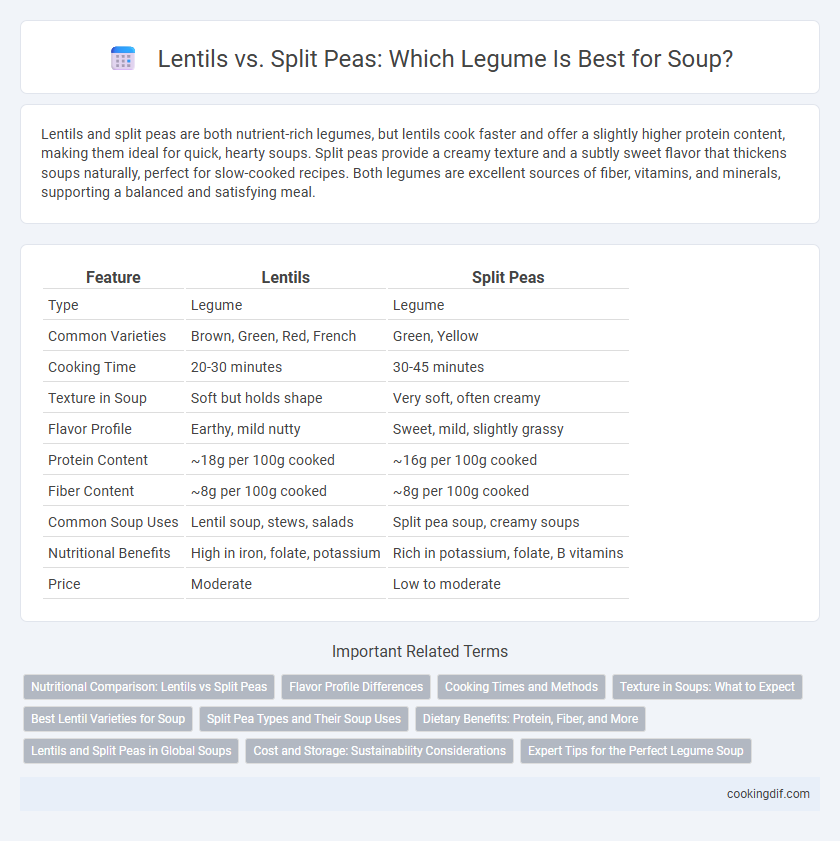Lentils and split peas are both nutrient-rich legumes, but lentils cook faster and offer a slightly higher protein content, making them ideal for quick, hearty soups. Split peas provide a creamy texture and a subtly sweet flavor that thickens soups naturally, perfect for slow-cooked recipes. Both legumes are excellent sources of fiber, vitamins, and minerals, supporting a balanced and satisfying meal.
Table of Comparison
| Feature | Lentils | Split Peas |
|---|---|---|
| Type | Legume | Legume |
| Common Varieties | Brown, Green, Red, French | Green, Yellow |
| Cooking Time | 20-30 minutes | 30-45 minutes |
| Texture in Soup | Soft but holds shape | Very soft, often creamy |
| Flavor Profile | Earthy, mild nutty | Sweet, mild, slightly grassy |
| Protein Content | ~18g per 100g cooked | ~16g per 100g cooked |
| Fiber Content | ~8g per 100g cooked | ~8g per 100g cooked |
| Common Soup Uses | Lentil soup, stews, salads | Split pea soup, creamy soups |
| Nutritional Benefits | High in iron, folate, potassium | Rich in potassium, folate, B vitamins |
| Price | Moderate | Low to moderate |
Nutritional Comparison: Lentils vs Split Peas
Lentils contain approximately 9 grams of protein and 8 grams of fiber per half-cup cooked, offering significant benefits for muscle repair and digestion. Split peas provide slightly higher fiber at around 8.1 grams and roughly 8 grams of protein per half-cup cooked, promoting heart health and sustained energy release. Both legumes are rich in essential minerals like iron, potassium, and magnesium, making them excellent choices for nutrient-dense soups.
Flavor Profile Differences
Lentils offer a mild, earthy flavor with a slightly peppery undertone, creating a delicate yet rich base for soups. Split peas deliver a sweeter, more starchy taste that thickens soups and provides a creamy texture. Choosing between lentils and split peas depends on whether a subtle complexity or a smooth, hearty consistency is desired.
Cooking Times and Methods
Lentils typically cook faster than split peas, with red lentils taking about 15-20 minutes and green or brown lentils around 30-40 minutes, while split peas generally require 45-60 minutes of simmering to become tender. Lentils do not need pre-soaking, making them convenient for quick soups, whereas split peas benefit from soaking to reduce cooking time and ensure even texture. Both legumes soften into creamy textures ideal for pureed soups, but lentils hold their shape better in chunkier recipes, influencing preferred cooking methods.
Texture in Soups: What to Expect
Lentils offer a creamy texture when cooked in soups, often softening quickly without losing shape, making them ideal for thick, hearty broths. Split peas break down more thoroughly, resulting in a smoother, almost puree-like consistency that enriches the soup's body and adds silkiness. Choosing between lentils and split peas depends on whether you prefer distinct legume pieces or a velvety, dense soup texture.
Best Lentil Varieties for Soup
Red lentils, known for their quick cooking time and smooth texture, are ideal for creamy soups and purees. Green lentils hold their shape well, offering a firmer texture and a slightly peppery flavor that enhances hearty vegetable or meat-based soups. Brown lentils provide a balanced earthiness and versatility, making them suitable for a variety of soup recipes that require a tender yet intact legume.
Split Pea Types and Their Soup Uses
Split peas come primarily in green and yellow varieties, each offering distinct flavors and textures ideal for soups. Green split peas have a slightly earthy taste and are commonly used in thicker, hearty soups, while yellow split peas provide a sweeter, milder flavor often preferred in Indian Dal soups and purees. Their fast-cooking properties and natural starch content create creamy, smooth textures, making them a versatile choice for various soup recipes focused on nutrition and comfort.
Dietary Benefits: Protein, Fiber, and More
Lentils provide about 18 grams of protein and 15.6 grams of fiber per cooked cup, supporting muscle repair and digestive health. Split peas offer slightly higher protein at 16 grams and an impressive 16.3 grams of fiber per cup, enhancing satiety and gut function. Both legumes supply essential nutrients like iron, folate, and potassium, making them excellent choices for heart health and energy metabolism.
Lentils and Split Peas in Global Soups
Lentils and split peas are staple legumes in global soups, prized for their rich protein content and distinct textures. Lentils, especially red and green varieties, are commonly used in Middle Eastern and Indian soups like dal and lentil stew, offering a creamy consistency and earthy flavor. Split peas, popular in European and North American split pea soups, provide a thick, hearty base with a slightly sweeter taste, making them ideal for comforting, nutrient-dense meals worldwide.
Cost and Storage: Sustainability Considerations
Lentils generally have a lower cost per pound compared to split peas, making them a budget-friendly option for soups while offering a long shelf life of up to a year when stored in airtight containers. Split peas also store well for up to 12 months under cool, dry conditions but tend to be slightly more expensive, influencing their sustainability from a cost-efficiency perspective. Choosing lentils can reduce food waste due to their longer viability and affordability, supporting sustainable cooking practices and economic ingredient use.
Expert Tips for the Perfect Legume Soup
Lentils and split peas both offer rich protein and fiber, but lentils cook faster and retain a firmer texture, ideal for soups aiming for a hearty bite. To achieve the perfect legume soup, experts recommend soaking split peas beforehand to reduce cooking time and enhance digestibility, while lentils generally require no soaking. Seasoning with bay leaves, garlic, and smoked paprika complements both legumes' earthy flavors, ensuring a depth of taste with every spoonful.
Lentils vs Split Peas for legumes Infographic

 cookingdif.com
cookingdif.com